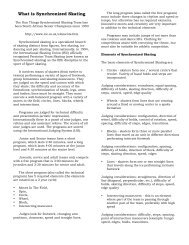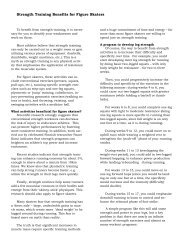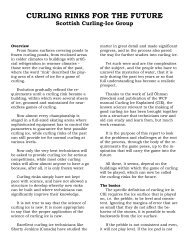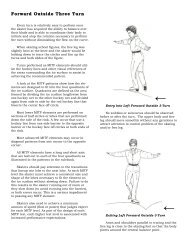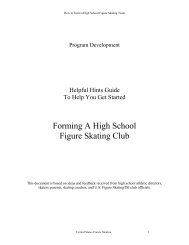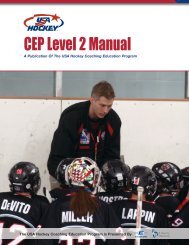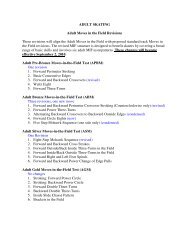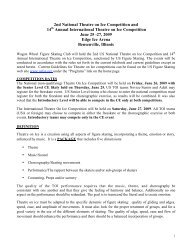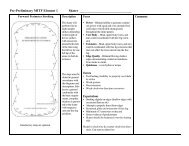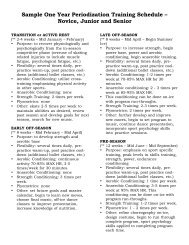CEP Level 3 Manual - Rushmore Hockey Association
CEP Level 3 Manual - Rushmore Hockey Association
CEP Level 3 Manual - Rushmore Hockey Association
Create successful ePaper yourself
Turn your PDF publications into a flip-book with our unique Google optimized e-Paper software.
T A B L E O F C O N T E N T S1. Briefly describe the new skill and then letthem try it several times in a quick paceddrill setting.2. Carefully observe their performance andidentify their strengths and weaknesses.(Use the key elements of the skill as a basisfor your observations).3. Call them back together and report yourobservations.This approach will allow you to point outweaknesses in performance on one or more keyelements that were common to many, if not all, ofthe players. Using this approach will enhance yourcredibility and motivate the players to listen to andfollow your instruction. Also, your subsequentteaching can be specifically matched to the needs(weaknesses) you observed. Of course, if in yourobservation of the players’ abilities you determinethat they have already achieved the desired skilllevel, then you should shift your focus to anotherskill. This could involve moving on to the next phaseof your practice plan.Individuals learn most effectively by focusingtheir practice attempts on one clearly understoodelement of skill performanceWhen your players are at two or three differentlevels of ability, you may want to establish two orthree instructional groups. This can beaccomplished using the following three divisions:Early learning: (focus on learning the keyelements of the skill)Intermediate Learning: (focus on coordination ofall key elements)Later Learning: (automatic use of the skill ingame-like conditions)STEP 2: Communicate Precisely What Needs tobe LearnedWhen you and your players know their status ona given skill (strengths and weaknesses of theirperformance), conditions are well established forboth teaching and learning. Because individualslearn most efficiently when they focus on oneaspect of a skill at a time, it is important tocommunicate precisely the one key element of theskill on which you want the individual, pair, groupor team to concentrate. Demonstrate the keyelement visually (and explain it verbally) so that allplayers know exactly what they are trying toachieve.STEP 3: Provide for Practice and FeedbackOrganize your practice time and select yourdrills or practice activity to provide players with:1. As many repetitions (trials) as possiblewithin the allotted time for instruction.Minimize standing in lines.2. Specific, immediate and positive feedbackon what they did correctly and then onwhat they can do to improve. Follow thiswith some encouragement to continue thelearning effort.Repetitions and feedback are essential toeffective coaching. You can expect a directrelationship between the gains in playerperformance and the degree to which you find waysto maximize these two dimensions of instruction.John Wooden, famed UCLA basketball coach, wasfound to provide over 2,000 acts of teaching during30 total hours of practice, of which 75 percentpertained directly to skill instruction. This convertsto more than one incidence of feedback for everyminute of coaching activity!Repeated trials and specific feedback on what wasright, followed by what can be improved, with anencouraging “try again,” produces resultsFeedback can be dramatically increased byusing volunteers and/or players as instructionalaids. Where instruction is focused on one keyelement of performance and the important aspectsof performing the skill have been effectivelycommunicated to the players, they are often asgood (and sometimes better) at seeingdiscrepancies in a partner’s performance as someadults. Working in pairs or small groups can thus bevery effective in increasing both the number of trialsand the amount of feedback that individuals getwithin a given amount of practice time. Also, byproviding feedback, players are improving theirmental understanding of how the skill should beperformed.STEP 4: Evaluate Results and Take AppropriateActionEvaluation of player performance must occuron a continuing basis during practices and in thegames. This is the only valid means to answer thequestion, “Are the players achieving the skills?” Ifthey are, you have two appropriate actions to take1. First, enjoy it. You are making an importantcontribution to your players.2. Second, consider how you can be evenmore efficient. Are there ways that you canget the same results in less time? Can evenhigher gains in skill be achieved within thesame time allotment?If the players are not achieving the instructionalobjectives, it is important to ask, “why?” Althoughit is possible that you have a cluster of players whoare slower learners, this is seldom the case. First,assume that you are using inappropriateinstructional techniques or that you simply did notprovide enough instructional time. A goodapproach to answering the “why” question is to goback through the instructional factors related toeffective planning, teaching, communicating,discipline and/or conditioning and determine whichof the guidelines or steps was missed and/orinappropriately implemented. Then alter yoursubsequent practices accordingly. Continuous trial,error and revisions will usually result in improvedcoaching effectiveness, which then translates intoincreased achievement by the players. In instanceswhere you cannot determine what to alter, seekhelp from a fellow coach whose team isconsistently strong in the skill(s) that are causingyou difficulty. This is an excellent way to obtainsome good ideas for alterations in your approach.SUMMARYEffective instruction is the foundation ofsuccessful coaching. It requires practices whichinclude a clear communication of what is to belearned, a continuous evaluation of playerperformance on the objectives included in thepractices, a systematic method of instruction, andthe use of guidelines for instruction which havebeen associated with player achievement.Systematic instruction includes: 1) estab-lishingattention and content credibility; 2) precisecommunication of what needs to be learned; 3)providing many practice trials and plenty offeedback; 4) evaluation of player achievement. Useof the guidelines for effective instruction (realisticexpectations, structured instruction, order,grouping, maximizing time, success, monitoringand providing a sense of control) will maximizethe results of instruction. Systematic instructionbased upon these guidelines of effective instruction,incorporated into effective practice plans, will resultin player achievement of the essentials of the game.REFERENCESBrophy, J.E. & Evertson, C. (1976). Learning from Teaching: ADevelopmental Perspective. Boston, MA: Allyn and Bacon.Bruner, J. (1981, August). On instructability Paper presented at themeeting of the American Psychological <strong>Association</strong>, Los Angeles,CA.Fisher, C.W., Berliner, D.C., Filby, N.N., Marliave, R.S., Cather, L.S. &Dishaw, M.M. (1980). Teaching behaviors, academic learning timeand student achievement: An overview. In C. Denham and A.Lieberman (Eds.) Time to learn. Washington DC: U.S.Department of Education, National Institute of Education.Fisher, C.W., Filby, N.N., Marliave, R.S., Cahen, L.S., Dishaw, M.M.,Moore, J.E. & Berliner, D.C. (1978). Teaching behaviors, academiclearning time, and student achievement. Final report of phase III-B,beginning teacher evaluation study, technical report. SanFrancisco, CA: Far West Laboratory for Educational Research andDevelopment.Rosenshine, B.V. (1983). Teaching functions in instructional programs.The Elementary School Journal, 83, 335-352.Rowe, M.B. (1974). Wait time and rewards as instructional variables:Their influence on language, logic, and fate control. Part one, Waittime. Journal of Research in Science Teaching, 11, 81-94.Rutter, M., Maugham, B., Mortmore, P. & Ousten, J. (1979). Fifteenthousand hours. Cambridge, MA: harvard University Press.Webb, N.M. (1980). A process-outcome analysis of learning in groupand individual settings. Educational Psychologist, 15, 69-83.14 | USA <strong>Hockey</strong> Coaching Education Program <strong>Level</strong> 3 <strong>Manual</strong>Role of the Coach | 15



